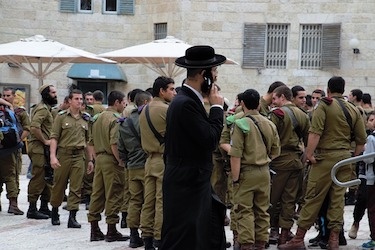
One of the frequent questions Rashi asks in his commentary to the Chumash is lamah nismicha, why are two parts of the Torah juxtaposed next to each other? The underlying assumption of the question is that these sections should not have been placed next to each other, i.e., the events did not occur successively. If such were not the case, there would be no basis for the question. When Rashi, for example, asks why the story of the meraglim follows that of the Miriam’s critique of Moshe, the commentaries are perplexed. Since the story of the meraglim actually did take place immediately after Miriam’s criticism of her brother, why should there be a need to explain the juxtaposition?
“Rabbi Inyani bar Sasson says: Why is the passage of the offerings juxtaposed to the passage of the priestly vestments? To teach us that just as offerings effect atonement, so, too, priestly vestments effect atonement” (Zevachim 88b).
Here, too, the question appears out of place. Can one think of two subjects that are better juxtaposed than the sacrifices and the clothing required of those who bring the sacrifices?
One could argue that while Rashi in his commentary only asks the question lamah nismicha if there is a reason to argue that the two texts should not be juxtaposed, the Midrash itself will ask this question even if it is clear why they are juxtaposed—and even if the events are listed in chronological order[1]. The Midrash is interested in elucidating additional lessons from the composition of the text, even if the text itself presents no difficulty.
Nonetheless, the commentaries do find a textual anomaly in the presentation of the korbanot and the clothes of the priests. The first seven chapters of sefer Vayikra detail the laws of sacrifices, and chapter eight then discusses the placement of the clothes on Aaron, who served as the first high priest. Yet in actual fact, the command regarding the clothing of the kohanim was given earlier than the laws of korbanot—and is described in great detail in sefer Shemot. Thus, the Gemara’s question of why the Torah addressed the laws of clothing a second time after the laws of korbanot. It would have been simpler to gather all the details of the clothing in one place—presumably in parshat Tetzaveh.
Ironically, this teaching of Rabbi Inyani bar Sasson is itself a product of lamah nismicha. It immediately follows another teaching of his. Commenting on the dispute as to whether the tunic worn by the high priest had 36 or 72 bells, “Rabbi Inyani bar Sason says: As there is a controversy here, so is there controversy with respect to leprous plagues. For we learnt: The appearances of plagues, Rav Dosa ben Hukinas said: They are 36; Akabia ben Mahalallel said: there are 18.”
These two teachings are the only ones by Rabbi Inyani bar Sasson recorded in the Talmud and would seem to have nothing in common save for the attribution, with such being reason enough to juxtapose them. Quoting all the teachings of a given Sage is a most common technique when dealing with rabbis who have a small number of teachings recorded in the Talmud.
A better-known example of this phenomenon are the two teachings of “Rav Natan bar Minyomi in the name of Rav Tanchum” (Shabbat 21b -22a). His first teaching, in the midst of a discussion on the laws of Chanukah, is that “the lights of the Chanukah [menorah] that are placed more than 20 cubits (approximately 30 feet) high is invalid, just like a sukkah and a mavui[2]”. Our printed texts then have two dots, indicating the end of a topic. The Gemara then continues with the second, seemingly unrelated, teaching of Rav Natan bar Minyomi in the name of Rav Tanchum. This is a well-known teaching, likely because Rashi included it his commentary to the Torah. “What [is the meaning] of that which is written: “and the pit was empty, there was no water in it” (Breisheet 37:24)? From the fact that it states ‘And the pit was empty’, don’t I know that there was no water in it? Rather, what does ‘there was no water in it’ teach us? Water was not in it, but snakes and scorpions were in it”.
What unites these unrelated teachings is the author—and these are the only two[3] teachings of his quoted in the Talmud.
As plausible as such an explanation may be, it is hard to accept that only names unite these teachings. What about other infrequently mentioned Sages whose teachings are not juxtaposed? We must search for thematic, not just technical, connections that might unite the teachings.
When one recalls that the brothers threw Joseph into the pit instead of killing him, one wonders why they would throw him into a pit filled with snakes and scorpions that could have potentially killed him. Rather, it is likely the brothers did not know that there were snakes and scorpions in the pit. But did they not look? Presumably they did, but did not see any of the creatures.
Why that is so is proof for the original teaching of Rav Natan bar Minyomi in the name of Rav Tanchum. A key component of Chanukah candles (and the roof of a sukkah and mavui) is that they must be seen. Rav Natan bar Minyomi in the name of Rav Tanchum teaches that one does not notice that which is 20 cubits high. The second teaching continues by positing that it is not only when items are higher that they might escape notice, but so, too, when they are lower, one is unlikely to notice that which is more than 20 amot away.
Similarly, we must search for a thematic connection between the two teachings of Rav Inyani bar Sasson. Before we can do that, we must understand his first teaching, which on the surface is rather strange. Regarding a tunic, we have a debate about whether there are 36 or 72 bells attached on the bottom. In what way is this connected to the debate as to whether there are either 36 or 18 forms of tzara’at? That in both cases one Sage suggests a number double the other is not much basis to join these teachings.
In expounding on Rav Inyani’s second teaching, the Gemara explains that the tunic atones for the sin of gossip, a sin that our Sages link to speaking lashon hara. What Rav Inyani saw—and his name, which is spelled עיניני, means “to see”—is that these two teachings contain a powerful lesson. The potential for atonement is twice as powerful as that of sin. There may be 36 different forms of gossip, but there are 72 areas where speech can be used for good. This idea is reflected in the rabbinic teaching that the reward for mitzvot is much greater than the punishment for sin.
This is something to rejoice about—hence, Rav Inyani is bar Sasson, the son of joy. Focusing on the good over the bad by at least a 2:1 ratio is bound to make our lives that much more joyous.
[1] For a fuller development of this idea, I recommend Nehama Leibowitz, Torah Insights, Eliner Library, Jerusalem, 1995, “Rashi’s Criteria for Citing Midrashim”, p. 101-105.
[2] A muvai is an alleyway. One of the ways of permitting members of the courtyards that abut the alleyway to carry on Shabbat is by placing a crossbeam, a korah, at a height of less than 20 amot at the opening.
[3] While Rav Inyani is only quoted in Zevachim 88b, Rav Natan bar Minyomi in the name of Rav Tanchum’s teaching regarding Chanukah candles is quoted verbatim in Bava Kamma (62b). The Talmud there is discussing whether a storeowner who places his Chanukah menorah on the street is liable for damages caused by a passerby’s flax catching on fire. In case you are wondering, he is. Performing a mitzvah should make one more careful to guard against unintended consequences.



